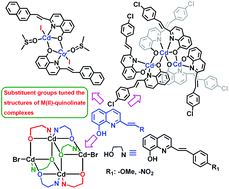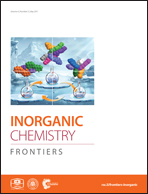Assembly of four 8-quinolinate-based multinuclear complexes: the effect of substituents on core structures and photoluminescence properties†
Abstract
Four multinuclear Cd(II) complexes, namely [Cd2(L1)2I2·2DMSO] (1), [Cd3(L2)6] (2), [Cd4(L3)6Br2] (3) and [Cd4(L4)6Br2·2DMF] (4), were prepared by the solvothermal reactions of Cd(II) salts with four 8-hydroxyquinoline ligands containing different substituent groups, respectively. The self-assembly behaviors of the cadmium salts and ligands were subsequently investigated using ultraviolet and fluorescence spectra. In the solid state, single-crystal X-ray diffraction analysis showed that complexes 1–4 exhibit an unprecedented structural diversification, and show one binuclear, one trinuclear and two tetranuclear Cd(II) building units, which can be attributed to the different substituent groups in 8-quinolinate ligands. As a result, the four Cd(II) complexes exhibit disparate photoluminescence properties (emission bands, fluorescence lifetimes and quantum yields). This unique capability may provide a useful strategy to tune the structures and optical properties of multinuclear materials, which could be exploited as important components for optoelectronic devices.

- This article is part of the themed collection: Inorganic Chemistry Frontiers HOT articles for 2017

 Please wait while we load your content...
Please wait while we load your content...